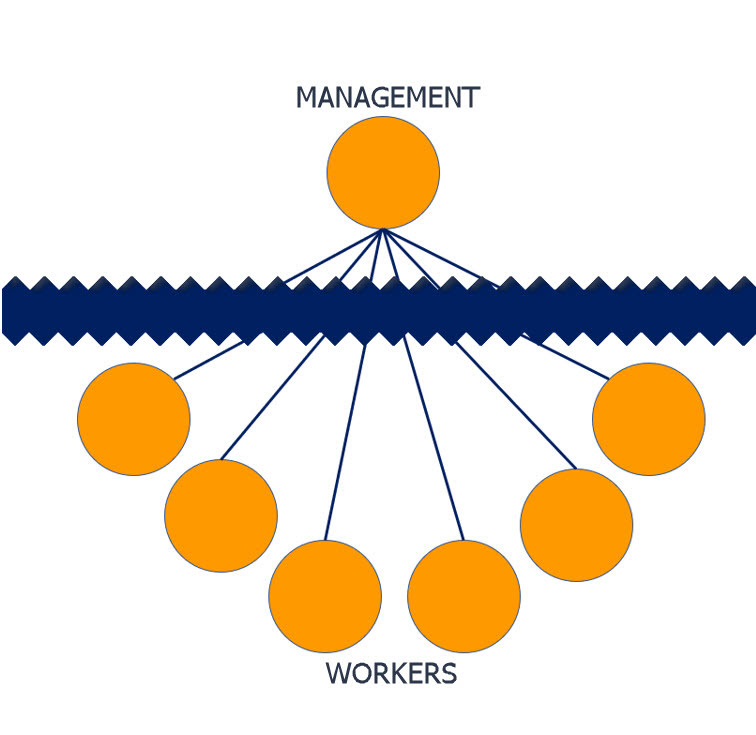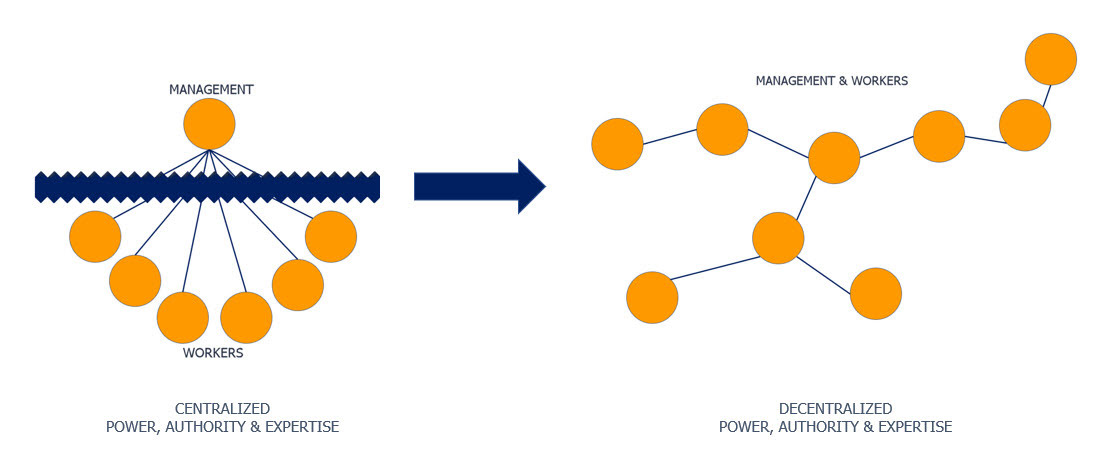Three Key Leadership Plays to Succeed with Agile
Two groups of leaders
Not too long ago, I was talking to a potential client, let’s call him Steve, who was interested in “going Agile”. Steve informed me that he was already very knowledgeable about Agile. He wanted his organization to “go Agile” to have faster product deliveries, better predictability, and better metrics.
…all are great reasons why organizations “go Agile”. Yet when I asked him what he’d do with better metrics, he gave me a reason to pause.
Steve’s reply: “We want to see how well the teams are performing, are we getting out of them what we are paying them to do? We can’t afford to have slackers. The pace nowadays is incredible…”
Needless to say, his response piqued my curiosity. I proceeded with more questions. I wanted to find out what he really knew about Agile and what he thought “going Agile” would entail.
As it turned out, this particular executive was deeply rooted in the outdated leadership mindset dating back to the industrial age. His aim was to use Agile metrics to improve his “command and control” approach and tighten his grip on teams using “data”. All of this while expecting his teams to execute faster, better, and be happier under his top-down control.
Unfortunately, Steve is not an exception. There are still executives who want to adopt Agile but use it as a means for the top-down rule. They expect to see Agile producing significant organizational results but continue leading using Industrial Age Mindsets and Manuals that are at odds with Agile values.
I’ve seen two types of leaders when it comes to creating and sustaining Agile organizations. There are leaders who want to “go Agile” and understand that doing so will introduce system-wide organizational changes. They adopt Agile and adapt their leadership style to reflect the Agile values. We’ll call them “Group 1”.
Then there are leaders, like Steve, that want to “go Agile” because they want to reap the benefits of Agile such as faster time-to-market, better product quality, and improved NPS scores without any adjustments to their leadership approach. They want to adopt Agile but are unwilling to adapt to Agile themselves. We’ll call these leaders “Group 2”.
These Group 2 leaders, in contrast to the first group, see Agile as a product delivery framework where the implementation is led by an expert (an Agile consultant or a coach) and implemented at a local, confined level. They see the Agile implementation as something that affects the teams at the execution level, leaving the executive leadership and the middle management to go about their work business as usual.
According to the 13th Annual State of Agile Report conducted in 2019 by Version One, the top three challenges to adopting and scaling Agile are:
- “An organizational culture that is at odds with Agile values,”
- “Inadequate management support and sponsorship” and
- “…general resistance to change.” (ColabNet VersionOne)
This article is about and for the second group of leaders. It is to help them and those working with them to first recognize themselves as belonging to the second group and then learn what it takes to start moving to the first group of leaders, the group that is cognizant of what it takes on all the levels of an organization to “go Agile”.
Before we talk about the actionable moves, the three key plays that will move leaders from Group 2 to Group 1, it is important to understand the leadership style of this second group, their belief systems and to what degree they think Agile implementations introduce changes within an organization.
The Outdated Leadership: Management vs. Workers Schism
 The leadership style of the Group 2 leaders has deep roots in the industrial age management methods going back all the way to Frederick Winslow Taylor. In his 1911 book “The Principles of Scientific Management”, Taylor revolutionized how work was done with his scientific management theory. Here he made very clear delineations between the management group that was responsible for planning how work had to be done (“thinkers”), and the workers that had to follow managers’ commands and do the work as told (“doers”). (Wikipedia)
The leadership style of the Group 2 leaders has deep roots in the industrial age management methods going back all the way to Frederick Winslow Taylor. In his 1911 book “The Principles of Scientific Management”, Taylor revolutionized how work was done with his scientific management theory. Here he made very clear delineations between the management group that was responsible for planning how work had to be done (“thinkers”), and the workers that had to follow managers’ commands and do the work as told (“doers”). (Wikipedia)
To the dismay of the unions and the skilled trade workers at the time, Taylor’s recommendations increased in popularity. As a result, the control of work was no longer in the hands of skilled laborers but in the hands of the management. The laborers were reduced to being mere order followers whose value was measured based on their utilization and performance outputs. Anyone who was not pushing themselves to the limit and who was not busy doing the manual work at all times was considered not “soldiering,” simply costing the company money.
Leadership Is Enablement: Farewell schism, hello management and workers unity…
For the Agile Methodology to be effective, leadership needs to transform its management processes along with the execution teams. While efficiency is still important, the management approach should be based on effectiveness in relation to the value created from the eyes of the customer. It needs to shift from the top-down to a more collective/servant leadership that I like to refer to as “enablement leadership.”
In the words of the great Klaus Schwab, the World Economic Forum founder:
“We need leaders who are emotionally intelligent, and able to model and champion co-operative working. They’ll coach, rather than command; they’ll be driven by empathy, not ego. The digital revolution needs a different, more human kind of leadership.”
(as cited by Artley)
Leaders are the ones in charge of the design of the organizational systems so it is imperative that the leadership approach and the characteristics that they display and foster as leaders are in line with Agile values.
It all starts with the leaders recognizing that Agile has the potential to optimize the organization on a system-wide level. Implementing Agile only as a product development method on one part of the organization that is housed within a collection of parts, and abdicating leadership and other parts of the organization from changing their approach is sub-optimizing Agile at best, and setting it up for failure at worst.
Implementing Agile transforms an organization horizontally and vertically. It impacts leaders and teams. It impacts the processes, people, and technologies and more importantly, it impacts the language, culture, behavior, and mindset of everyone in the organization.
Agile as a system is akin to that of a live organism. It is like a tree that relies on favorable conditions to thrive and bear fruit.
 Here the job of leaders is to strategically go about creating the necessary conditions to get the most out of Agile, depending on the weather trends/market conditions.
Here the job of leaders is to strategically go about creating the necessary conditions to get the most out of Agile, depending on the weather trends/market conditions.
So, if the leap from Taylorism is too great, leaders can start the transition with the gentle approach of asking themselves, not how to maximize the utilization of workers based on time and output, but how to utilize Agile to its full potential:
- What conditions are necessary for preparation for “planting” Agile?
- What is the definition of fertile ground in which Agile will thrive?
Enablement Of Conditions: 3 Critical Plays To Position Your Organization For Success
The shift to “enabling” the necessary context and culture and thus the fertile ground for Agile to thrive requires three significant shifts in the mindset, beliefs, and actions of Group 2 leaders. The three shifts are:
- Focus on collective intelligence
- Creation of psychological and professional safety to innovate
- Base KPIs and rewards on value creation, not utilization
Shifting from an outdated leadership style while shifting the conditions of an organization to embrace and foster Agile is not a small matter. The effort to change the various variables on the individual level and organizational levels at the same time requires conscious and continuous effort. These three moves are a small number of plays that leaders need to take, yet they are critical in positioning them to transition from Group 2 to Group 1 and in making Agile transformations successful.
Play 1: Focus on Collective Intelligence
“Collective intelligence” as a term was coined by Thomas Malone, the Patrick J. McGovern Professor of Management at MIT and the founding director of the MIT Center for Collective Intelligence. The basic premise of collective intelligence is the idea that a group of individuals who are working together creates intelligence that is not possible on an individual level. (What is Collective Intelligence?)
So, the first step that Group 2 leaders need to do in setting up Agile for success is to remove Taylor’s chasm between the management and teams and tap into the potential that the collective intelligence has to offer.
 Management and the workers have to work in unity towards the common organizational goals that the Agile implementation is driving.
Management and the workers have to work in unity towards the common organizational goals that the Agile implementation is driving.
It is key for leaders to acknowledge that teams are not just “doers” executing what they are being told. They are thinkers, problem-solvers, and leaders, too. By acknowledging this, leaders will increase the collective intelligence of the organization and be in a better position to innovate and meet the challenges of the rapidly changing, complex market.
Play 2: Create Psychological And Professional Safety To Innovate
To be able to tap into and maximize the “collective intelligence” of an organization, leaders are responsible for creating an environment for teams that allows for open communication, creativity, calculated risk-taking, and failure.
This environment is created by inviting teams to share ideas and challenging each other and the leadership. It is affirmed by leaders rewarding challenge-seekers and problem-solvers, by exemplifying open communication between teams and management.
Studies have shown that “smart teams” — teams with high collective intelligence — are not necessarily a group of individuals with high IQs, but a group of individuals who “communicate a lot, participate equally, and possess good emotion-reading skills.” (Wolley, Malone, and Chabris)
Leaders have to encourage and reward these desirable behaviors.
Play 3: Base KPIs And Rewards On Value Creation Not Utilization
While some old leadership behaviors have to change as part of transforming an organization into an Agile one, the thirst for metrics and measurable data is something that both the old-fashioned managers following Taylor’s principles and successful Agilists have in common.
The key difference is what type of metrics we want to use in an Agile organization and for what purpose.
While scientific management calls for metrics to ensure adherence to the prescriptive methods that management has set, in an Agile environment metrics are used to diagnose where teams need help from management. In a well-functioning Agile environment, leaders help teams solve the challenges — they don’t use metrics as data justifying the punishment of low performers.
In line with the Agile mindset and values, KPIs and rewards should not be based on maximizing the utilization of resources. Workers should not be managed by the clock based on the volume of output. If the objective of the organization is to create value as it is defined by the customer, the KPIs and rewards ought to align with that goal.
As always, KPIs are organization-specific and specific to the goals as well as organizational Agile maturity. One way to empower teams is to give them room to experiment and reward problem-solving and proactive value optimization and creation. Be it by ensuring that teams have the velocity reserved to innovate or by organizing regular innovation events, leaders need to allocate time and space for teams to innovate and reward them for doing so.
As outlined here, management and executive leadership not only have a role in an Agile organization, but their role is a very significant one.
It is one of enablement, empowerment, and organizational optimization on a system level.
It is to tap into the potential of collective intelligence by respecting the knowledge and the creativity of the individual contributors.
It is to create an environment and reward systems reinforcing controlled risk-taking, innovation, and problem-solving.
So, if Steve and leaders like Steve want higher revenue and want to innovate, micromanaging knowledge workers based on outdated Industrial Age Manuals will not turn them into industry leaders of the future.
On the contrary, unless such leaders are willing to change their leadership approach to enabling teams rather than controlling them, the “command and control” micromanagement will efficiently take them top-down: from the top, down into the oblivion of the Industrial Age itself, where companies that could not evolve with times have become relics of the past themselves.
Works Cited
“13th Annual State of Agile Report.” CollabNet VersionOne, May 7th, 2019, Retrieved from: https://www.stateofagile.com/#ufh-i-521251909-13th-annual-state-of-agile-report/473508
“Frederick Winslow Taylor.” Wikipedia. Retrieved from: https://en.wikipedia.org/wiki/Frederick_Winslow_Taylor
Artley, Jennifer. “How to Be A Leader in the Fourth Industrial Revolution.” January 19, 2018. weforum.org. Retrieved from: https://www.weforum.org/agenda/2018/01/how-to-be-a-leader-in-the-fourth-industrial-revolution/
“What Is Collective Intelligence?” Organizational Psychology Degrees. Retrieved from: https://www.organizationalpsychologydegrees.com/faq/what-is-collective-intelligence/
Woolley, Anita. Malone, Thomas W. and Chabris, Christopher F. “Why Some Teams Are Smarter Than Others.” New York Times. Retrieved from: https://www.nytimes.com/2015/01/18/opinion/sunday/why-some-teams-are-smarter-than-others.html?_r=2











